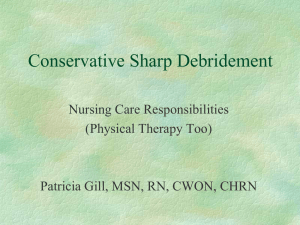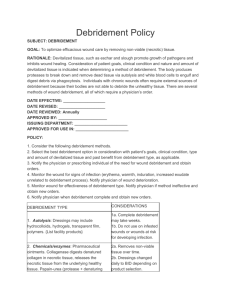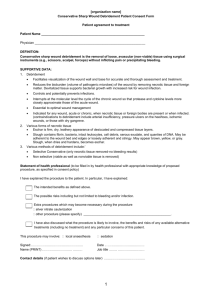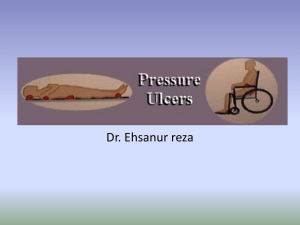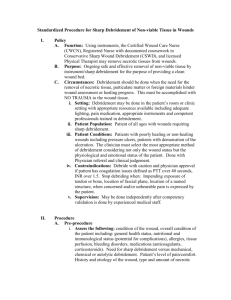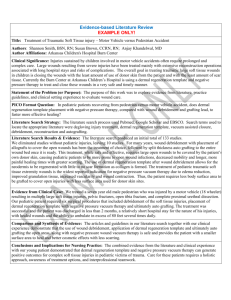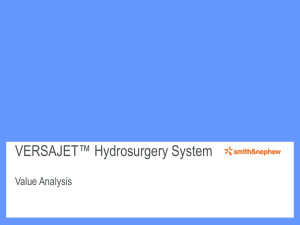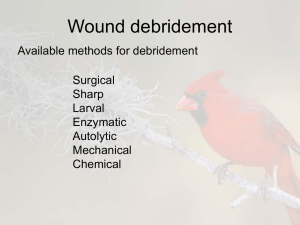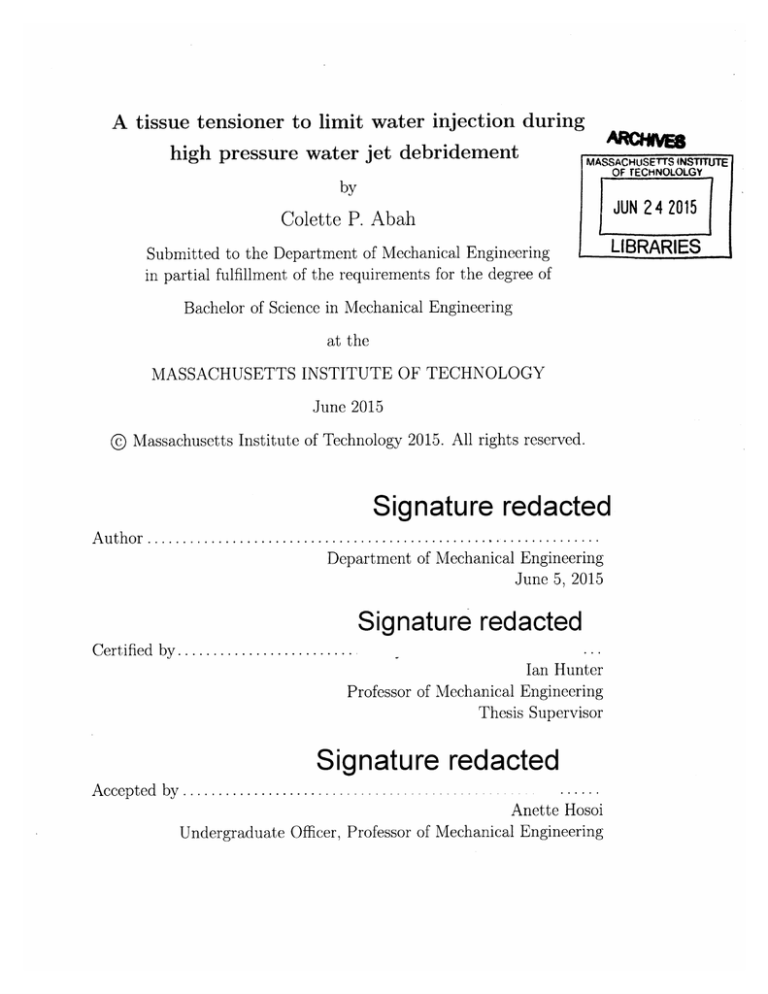
A tissue tensioner to limit water injection during
high pressure water jet debridement
MASSACHUSETTS
INSTITUTE
OF TECHNOLOLGY
by
JUN 24 2015
Colette P. Abah
LIBRARIES
Submitted to the Department of Mechanical Engineering
in partial fulfillment of the requirements for the degree of
Bachelor of Science in Mechanical Engineering
at the
MASSACHUSETTS INSTITUTE OF TECHNOLOGY
June 2015
O Massachusetts Institute of Technology 2015. All rights reserved.
Signature redacted
.. . .. .. . . . .. . . . . .. .. . . . . . .... . . .
Department of Mechanical Engineering
June 5, 2015
.
A u th o r . .... . ... .. .. . . .. .... .. . .
Signature redacted
Certified by.........................
Ian Hunter
Professor of Mechanical Engineering
Thesis Supervisor
Signature redacted
......
Anette Hosoi
Undergraduate Officer, Professor of Mechanical Engineering
Accepted by .......................
A Tissue Tensioner to Limit Water Injection During High
Pressure Water Jet Debridement
by
Colette P. Abah
Submitted to the Department of Mechanical Engineering
on June 5, 2015, in partial fulfillment of the
requirements for the degree of
Bachelor of Science in Mechanical Engineering
Abstract
Removing necrotic tissue and foreign materials from wounds is a critical step in the
management and treatment of chronic wounds. MIT's BioInstrumentation Laboratory developed a novel debridement technology that uses two high-speed impinging
water jets to excise necrotic tissue. However, this device potentially causes accidental
injection of water into healthy tissue beneath the wound bed, which can cause injury
and necrosis in the healthy tissue. The purpose of this thesis is to explore tissue tension as a solution to reduce the required cutting power and consequently reduce water
injection to acceptable levels. After validating the positive effect of tissue tension on
the cutting efficiency of the water jet debridement device, we developed a technology
that uses angled rolling wheels to tension tissue prior to debridement. This novel
tensioner was qualitatively tested and successfully applied local tension at the site of
cutting. Suggestions for further testing to improve this device are given. This tissue
tensioner shows promise as a complementary appendage to the water jet debridement
device.
Thesis Supervisor: Ian Hunter
Title: Professor of Mechanical Engineering
3
4
Acknowledgments
I would like to thank my faculty supervisor, Professor Ian Hunter, for the opportunity
to work in the BioInstrumentation laboratory this semester.
It was an incredible
learning experience and I came out a better scientist and engineer.
I would like to thank my graduate adviser, Ashley Brown, for her guidance and
mentorship throughout this project. She is a great teacher and a brilliant engineer. I
am grateful for the knowledge she has imparted to me.
To the members of the BioInstrumentation lab, it was a pleasure to work with
you and learn from your expertise.
Rachel and Marie, thank you for helping me with testing.
for regularly checking up on me (and my sanity).
Maxine, thank you
Abir and Jerop, thank you for
To my family and to the friends I now
providing food, entertainment and hugs.
call family, thank you for your unconditional love and support. Your kind words of
encouragement kept me strong in the most challenging times.
To my brother, Alain, I dedicate my MIT degree to you. Thank you for teaching
me that I can achieve anything I want, if I want it badly enough.
To my Heavenly Father, thank you for the amazing grace to survive and thrive at
MIT.
5
6
Contents
Bibliography
13
1
Introduction
15
2
Background
17
. . . . . .
. . . . . . . . . .
17
2.2
Debridement Techniques . . . . . . . . . . .
. . . . . . . . . .
18
2.2.1
Excising Debridement Techniques . .
. . . . . . . . . .
18
2.2.2
Novel Debridement Method
. . . . . . . . . .
20
.
.
.
25
. . . . . . . . . .
25
3.1.1
Simulating a Sloughy Wound
. . . .
. . . . . . . . . .
25
3.1.2
Setup to Supply High Pressure Water
. . . . . . . . . .
27
3.1.3
Nozzle Maintenance with Fret Filters
. . . . . . . . . .
30
3.1.4
Setup for Uniaxial Tensioning . . . .
. . . . . . . . . .
30
.
. . . . . . . . . .
34
Effect of Tensioning on Cutting Efficiency
.
.
Experimental Setup . . . . . . . . . . . . . .
.
3.2
5
. . . . .
Proof of Concept
3.1
39
4.1
Design Concept . . . . . . . . . . . . . . . . . . . . . . . . . . . . .
39
4.2
Interface with Dual Nozzle Debridement Device . . . . . . . . . . .
46
4.3
Prototype Evaluation . . . . . . . . . . . . . . . . . . . . . . . . . .
49
.
.
Tissue Tensioner Design
.
4
.
Management of Chronic Wounds
.
3
2.1
Conclusions and Future Work
51
7
8
List of Figures
2-1
Method for excising tissue with two nozzles. In (A), the nozzles each
simultaneously make a cut. Because the nozzles are angled towards
each other, their cuts separate a section of tissue, which has been
removed in (B). Reproduced from [1]
2-2
. . . . . . . . . . . . . . . . . .
20
Each nozzle is mounted in a nozzle arm that can swivel, thus changing
the angle of the jets. The two arms are mounted in separate blocks.
A knob controls the relative distance between the two blocks.
By
swiveling the nozzle arms and turning the knob, the angle and the
distance between the nozzles can be adjusted. Reproduced from [1]
2-3
. . . . . . . . . . . . . . . . . . . . . . . . . . .
24
Slough was simulated by treating post-mortem porcine abdominal tissue with 10% acetic acid . . . . . . . . . . . . . . . . . . . . . . . . .
3-2
22
A cross section of the water jet cutting device showing the water path.
Reproduced from [11
3-1
.
26
Cross section of porcine tissue after treatment with 10 percent acetic
acid. Reproduced from [11 . . . . . . . . . . . . . . . . . . . . . . . .
9
27
3-3
Diagram showing setup components. At the input, 550 kPa air is fed
through a ball valve to a solenoid valve. On its way to the pump, the air
passes through a bleeder muffler, an adjustable pressure switch, and a
400 kPa dial pressure gauge. The air supplied to the pump is controlled
coarsely by adjusting the ball valve, and finely by allowing the air to
bleed out through a bleeder muffler. Both the pressure switch and the
emergency stop are able to cut off power to the solenoid valve, causing
the valve to close and isolating the pump from the air supply.
The
pressure switch is set to activate at 700 kPa, higher than the pressure
of the compressed air available, yet still less than 1.4 MPa for which
all the air supply fittings are rated. All connections in the air supply
fitting are 0.25 NPT. Reproduced from[1] . . . . . . . . . . . . . . . .
28
3-4
Experimental setup to supply high pressure water. Reproduced from [1] 29
3-5
Fret filter press-fitted into an acrylic washer. A. The square configuration was structurally weak due to stress concentration at the corners
of the square acrylic hole. B. The circular configuration was successful
in reducing the frequency of nozzle clogging
3-6
. . . . . . . . . . . . . .
31
Exploded view of a nozzle arm and its internal components. Acrylic
crush washers and fret filter are sandwiched between the nozzle and
the elbow (not shown). The nozzle arm is made watertight through
the compressing action of a threaded cap . . . . . . . . . . . . . . . .
3-7
31
The tissue dermis is held in tension by two steel bulldog clips at opposite ends. The first clip is fixed to a force sensor while the second clip is
fastened to an MK 50 mmAluminum profile base. The position of the
second clip is adjustable. The gap between the two clips determines
the level of tension applied to the skin. This tension is measured by
the force sensor... ..
3-8
. ..
.........
...
. . . .
33
Tension applied on the dermis of simulated necrotic tissue. The blue
arrows represent the direction of uniaxial tension
3-9
. . . . . . ..
. . . . . . . . . . .
Single nozzle debridement device. Reproduced from [1]
10
. . . . . . . .
34
34
3-10 The depth of cut achieved by the water jet debridement device was
measured using a ruler. The depth of cut value was accurate to 0.5 mm
uncertainty
. . . . . . . . . . . . . . . . . . . . . . . . . . . . . . . .
35
3-11 Graph of depth of cut versus applied uniaxial tension at constant water
pressure P = 15 M Pa . . . . . . . . . . . . . . . . . . . . . . . . . . .
4-1
37
Contact force exerted by two angled rolling wheels. The black rectangles represent the two wheels. The gray arrows are the x-components of
the force and the red arrows are the y-components. The y-components
of the contact force are in opposite directions, hence creating local surface in the y-direction tension between the wheels in the y-direction.
Note that the direction of propagation is in the positive x-direction.
4-2
.
40
Angled wheels tensioner. Two wheels, 25.4mm in diameter, are linked
together such that their are at angle from each other. A compass-like
component enables angular adjustment. The tensioner also includes a
handle for maneuverability . . . . . . . . . . . . . . . . . . . . . . . .
4-3
42
Compact Angled wheels tensioner(front view). The wheels are 25.4 mm
in diameter. An extruded trapezoid serves as both a chassis for the
angled wheels and a handle for maneuverability purposes . . . . . . .
4-4
43
Bottom view of the Angled wheels tensioner. The angle between the
two wheels is 45 . . . . . . . . . . . . . . . . . . . . . . . . . . . . .
44
4-5
The extruded trapezoid handle enables a comfortable three-fingers grip
45
4-6
Interface of dual nozzle debridement device [1] with angled wheels tensioner(side view )
4-7
. . . . . . . . . . . . . . . . . . . . . . . . . . . . .
47
Interface of dual nozzle debridement device [1] with angled wheels tensioner(top view ) . . . . . . . . . . . . . . . . . . . . . . . . . . . . . .
11
48
4-8
Qualitative evaluation of tensioner. A grid, with squares of dimensions
10 mm by 10 mm was drawn on flattest area of a subject's forearm.
The tensioner was slowly rolled from one end of the grid to the other.
Step-by-step photographs of the grid were taken in order the visualize
the how the tensioner affects the shape of the grip lines.
4-9
. . . . . . .
49
Four frames, right to left, show the effect of the rolling wheels on the
grid geometry.The white dotted lines reveals that the grid lines warp
away from each other when in contact with the rolling wheels of the
tensioner. This phenomenon confirms that the rotation of the angled
wheels causes tension skin tension in the direction perpendicular to the
direction of travel.
. . . . . . . . . . . . . . . . . . . . . . . . . . . .
12
50
List of Tables
2.1
Comparison of debridement techniques.
1 = most appropriate; 4 =
least appropriate. Adapted from [2] . . . . . . . . . . . . . . . . . . .
13
19
14
Chapter 1
Introduction
Chronic wounds represent a significant burden to patients, health care professionals
and the US health care system, costing about $25 billion annually [3][4]. Approximately 3 to 6 million Americans are affected by chronic wounds, especially due to
venous ulcers, pressure ulcers and diabetic ulcers [5][6].
Most chronic wounds are
non-healing; of all cases of venous and diabetic ulcers, only 25 to 50% heal after
twenty weeks of treatment [7].
Debridement, the removal of necrotic tissue and foreign materials from a wound,
is an essential step in the treatment of chronic wounds [8].
There currently exist
many debridement techniques, but the search for novel and more effective techniques
is ongoing [9]. MIT's BioInstrumentation laboratory developed a novel debridement
device that uses two high-speed impinging water jets to excise necrotic tissue [1]. The
current alpha prototype of this device was successful in debriding a surface with sideby-side cuts, implementing a suction technique to remove waste and reducing water
injection through pre-scoring the tissue.
The use of the water jets on soft tissue caused water injection into healthy tissue
underneath the wound bed. The lowest injection level achieved by the water jet debridement device is 4.3 L m-2, which is higher than the 3 L m-
2
maximum acceptable
injection value [10].
Tensioning tissue prior to cutting with the water jet device is a potential solution to
reduce water injection in the tissue, as less force is required to cut tissue under tension
15
[11]. Applying tension to the tissue prior to cutting will reduce the required cutting
pressure and consequently, the water injection[1]. This thesis describes the design a
novel technology to tension tissue surface and prevent excessive water injection, in
order to increase patient outcome post water jet debridement.
Chapter II provides background information on the treatment of chronic wounds
and MIT's BioInstrumentation Laboratory's novel water jet debridement device.
Chapter III investigates the effect of tissue tensioning on the cutting efficiency of
the water jet debridement device. Chapter IV presents the design and performance
of a novel tissue tensioner. Finally, Chapter V evaluates the device capabilities and
discusses future work.
16
Chapter 2
Background
2.1
Management of Chronic Wounds
A wound is a breach of the skin's outer protective layer, epidermis, that can lead to
infection and sepsis [12]. There are two types of wounds: chronic wounds and acute
wounds. Acute wounds are caused by trauma or through surgery and heal in four
overlapping stages[12] [13]. Chronic wounds are any interruption in the continuity of
the body's surface that requires a prolonged time to heal, does not heal, or recurs
[6][14]. Chronic wounds are especially common in patients with diabetic, venous and
pressure ulcers.
The healing process for acute wounds follows a well-defined healing process, with
four overlapping stages, that can last for months [12]. Coagulation initiates the
wound healing process by releasing clot of platelets embedded in a mesh of crosslinked fibrin fibers that act as a temporary shield for the denuded wound tissues [15].
At the inflammation stage, inflammatory cells are recruited from circulating blood
to the wound site through chemotactic signals. Neurophils clears the initial rush of
bacteria and macrophages clear the remaining pathogenic cells and matrix debris.
At the cell proliferation and matrix repair stage, capillaries penetrate the cloth
and form granulation tissue. Fibroblasts then fill the wound site with interim wound
matrix, while epithelial cells multiply at the wound edge before migrating across the
granulation tissue and forming a new epidermis. This stage can last for several weeks.
17
The final stage of wound healing is epithelialization and remodeling of the scar
tissue. This stage can last up to several months and is characterized by the synthesis
of a new extra-cellular matrix and the apoptosis of unneeded cells [12] [1].
Chronic wounds do not follow the same well-sequenced healing stages as acute
wounds. The healing of chronic wounds get disrupted at one or many stages. In order
to transform the molecular and cellular environment of a wound bed from chronic into
acute, the barrier to healing must be identified and removed using adequate methods
[12]. Wound bed preparation is a chronic wound management technique that converts
non-healing wounds into acute wounds through debridement, management of exudate
and resolution of bacterial imbalance [12].
2.2
Debridement Techniques
Debridement is an essential step in both acute and chronic wound management. It is
the technique used to clear wounds of necrotic tissue and bacteria in order to promote
healing [12]. In chronic wounds, necrotic tissue provides a focus for infection, prolongs
the inflammatory phase, obstructs contraction and prevents re-epithelialization [16].
2.2.1
Excising Debridement Techniques
There are five different types of the debridement techniques, each with its advantages
and limitations [17] [12]:
Autolytic debridement is the process by which the wound bed clears itself of
debris by utilizing phagocytic cells and proteolytic enzymes[18].
This debridement
technique is easy to perform, natural, selective, painless and most appropriate for
wounds with minimal debris. Unfortunately, this technique is prohibitively slow [17].
Enzymatic debridement describes the application to the wound bed of protolytic enzymes such as collagenase able to chemically digest and breakdown cellular
debris [19].
This debridement technique is easy to perform, selective and painless.
However, this process is slow and the enzymes may be inactivated by the wound's pH
level [17].
18
Table 2.1: Comparison of debridement techniques. 1 = most appropriate; 4 = least
appropriate. Adapted from [2]
Speed
Tissue selectivity
Painful wound
Exudate
Infection
Cost
Autolytic
Surgical
Enzymatic
Mechanical
4
3
1
3
4
1
1
2
4
1
1
4
2
1
2
4
3
2
3
4
3
2
2
3
Mechanical debridement describes the process of physically removing debris
from a wound bed. This debridement method includes procedures such as wet-to-dry
dressings, hydrosurgery, irrigation and dextranomers [20] [21]. Mechanical debridement is easy to perform, faster than both autolytic and enzymatic debridements,and
useful for wounds with necrotic materials and moderate to large amounts of exudate.
However, this method is non selective and may damage or remove viable tissue in the
process [17].
Surgical and sharp debridement is the excision of non-viable tissue using
sharp instruments such as scalpels, curettes, or scissors[17]. Surgical debridement is
the fastest and most effective way to remove debris and necrotic tissue [12]. This
method is commonly use with widespread infections or with septic patients
[12].
However, surgeons are taught to debride until bleeding occurs [22], which make this
debridement method extremely painful and risky for the patient's immune system.
This technique is also very costly [2] and requires the presence of a trained clinician
[17].
Larval Therapy involves the dissolution of necrotic tissue by using the enzymes
present in green bottle fly saliva. This method is efficient, safe and simple to perform
[23] but is only applicable to specific wound characteristics [171.
Table 2.1 summarizes the advantages and drawbacks of each debridement technique [2].
19
5 mm
A
5 mm
B
Figure 2-1: Method for excising tissue with two nozzles. In (A), the nozzles each
simultaneously make a cut. Because the nozzles are angled towards each other, their
cuts separate a section of tissue, which has been removed in (B). Reproduced from
[11
2.2.2
Novel Debridement Method
MIT's BioInstrumentation laboratory developed a novel device that employs two simultaneous high pressure water jets to debride necrotic tissue from wounds [1]. The
water jets are impinging, such that most of their kinetic energy is dissipated into
atomization and the device is able to excise sample strips of the epidermis without
perforating deeper skin layers. As illustrated in Figure 4-9, the two jets make simultaneous parallel cuts. Because the nozzles are angled to intersect at the subsurface,
their motion excises a sample of the tissue [1].
20
As illustrated in Figure 2-2, each nozzle is mounted in a nozzle arm that can
swivel, thus changing the angle of the jets. The two arms are mounted in separate
blocks and a knob controls the relative distance between the two blocks. By swiveling
the nozzle arms and turning the knob, the angle and the distance between the nozzles
can be adjusted. Figure 2-3 shows the water path within the device [1].
21
rNozzle arms
10 mm
Figure 2-2: Each nozzle is mounted in a nozzle arm that can swivel, thus changing the angle of the jets. The two arms are
mounted in separate blocks. A knob controls the relative distance between the two blocks. By swiveling the nozzle arms and
turning the knob, the angle and the distance between the nozzles can be adjusted. Reproduced from [1]
The pressure needed to debride tissue depends on both the jet configuration and
the properties of the tissue. The device was tested on simulated sloughy tissue at
optimum parameters of 75 pm orifices nozzles spaced 2 mm apart at 1100 from each
other, this device was able to excise soft tissue at 6 MPa of water pressure [1].
However, cuts made in simulated sloughy tissue caused the two-nozzle device
caused water to inject into healthy tissue beneath the wound bed. Excessive water
injection can cause injury and necrosis in healthy tissue [24J, which would make this
device counterproductive.
Two methods to reduce the water injection have previously been explored and
implemented. Increasing the speed on translation during cutting reduced the water
injection but also lead to cuts of unreliable quality and shallower depth. The second
method used surgical blades to incise the sample prior to cutting with the water jets.
The use of surgical blades in conjunction with the debridement device reduced the
water injection. Still, the lowest injection level achieved by the water jet debridement
device is 4.3 L m-2, which is higher than the 3 L m- 2 maximum acceptable injection
value [10].
Tensioning tissue prior to cutting with the water jet debridement device is a
potential solution to reduce water injection in the tissue. Indeed, less force is required
to cut tissue under tension [11], and so applying tension to the sample may reduce
the required cutting pressure and consequently reduce the water injection [11]
The next chapter explores tension as a solution to reduce the water injection
during water jet debridement through an experiment aimed to prove the effect of
tissue tension on achieved depth of cut.
23
Fixed Block
O-ri ng
Movable Block
Base Plate
W
10 mm
rPath
Figure 2-3: A cross section of the water jet cutting device showing the water path.
Reproduced from [11
24
Chapter 3
Proof of Concept
It was hypothesized that tensioning tissue prior to cutting with a water jet debridement device could increase the cutting efficiency, hence decrease water injection in
healthy tissue beneath the wound bed. This Chapter described a proof of concept
experiment that measures the effect of tissue tensioning on the depth of cut achieved
by the water jet debridement device at constant water pressure.
3.1
Experimental Setup
In this experiment, we put simulated sloughy tissue under varied levels of uniaxial
tension while keeping the cutting pressure constant, 15 MPa. We simulated a sloughy
wound, supplied high pressure water, optimized flow through nozzle maintenance and
performed a debridement test with tissue under uniaxial tension.
3.1.1
Simulating a Sloughy Wound
Slough is a stringy mass of devitalized tissue whose color indicates the level of bacterial colonization [1]. White slough has a low colonization level, while yellow or green
slow have higher bacterial counts [25]. Slough was simulated for this experiment to
represent soft necrotic tissue. The structure of slough was mimicked by degrading
the extracellular matrix (ECM) of bovine tissue samples with acetic acid at 10%
25
Untreated tts*ue
Acetic acid
Figure 3-1: Slough was simulated by treating post-mortem porcine abdominal tissue
with 10% acetic acid
concentration. In healthy skin, dermal ECM, which is composed of collagen in characteristic triple-helix configuration of three polypeptide chains, serves as a support
structure [26]. Dilute acetic acid causes collagen to swell, unfold, and partly dissolve
[27]. Concentrations as low as 0.3% for one hour cause a substantial re-arrangement
of intermolecular bonds in rat tail tendons [281.
Slough was simulated by applying 10% acetic acid to a sample of post-mortem
porcine abdominal tissue, as illustrated in Figure 3-1.
The acid was pooled on the
surface of the sample, which was then sealed and incubated for at least three hours
at room temperature, 25 C. The sealed sample was then stored at 4 C. All tests
were conducted at room temperature.
Treatment with acetic acid made the tissue dermis stiff and translucent, as shown
in Figure 3-2, in contrast to the supple and opaque pre-treated tissue from Figure 3-1,
due to broken-down collagen. The acid treated porcine tissue successfully mimicked
important characteristics of sloughy wounds [1].
26
DermisFat
Muscle
Figure 3-2: Cross section of porcine tissue after treatment with 10 percent acetic acid.
Reproduced from [11
3.1.2
Setup to Supply High Pressure Water
In order to perform debridement with the water jet device, high pressure water was
supplied to the system. The pressure setup, illustrated in Figure 3-4, was designed
and built by Ashley Brown [1].
A Maxpro Technologies [29] pneumatic piston pump was used and supplied between 2 and 85 MPa. At 20 MPa, the flow rate was 0.011 L s-1, comparable to the
flow rate used in jet injections. The output pressure oscillated through a range of
about 5 MPa. Throughout this experiment, the minimum value of the oscillation was
set as the reference cutting pressure.
Figure 3-3 shows a detailed diagram of the auxiliary hardware used to control
the water supply. The experiments were performed inside the polycarbonate safety
enclosure. Latex globes, a face shield and a lab coat were worn as all time.
27
550kPa Air
Enmergency Stop
Ball Valve
Solenoid
Valve
Bleeder
Muffler
120 VAC
Pressure
Switch
Gauge
s.e
Water
Lo
High Pressure
Gauge
*
Piston
Pump
Needle
Valve
Water
Supply
lHandpiece
Figure 3-3: Diagram showing setup components. At the input, 550 kPa air is fed
through a ball valve to a solenoid valve. On its way to the pump, the air passes
through a bleeder muffler, an adjustable pressure switch, and a 400 kPa dial pressure
gauge. The air supplied to the pump is controlled coarsely by adjusting the ball
valve, and finely by allowing the air to bleed out through a bleeder muffler. Both the
pressure switch and the emergency stop are able to cut off power to the solenoid valve,
causing the valve to close and isolating the pump from the air supply. The pressure
switch is set to activate at 700 kPa, higher than the pressure of the compressed air
available, yet still less than 1.4 MPa for which all the air supply fittings are rated. All
connections in the air supply fitting are 0.25 NPT. Reproduced from[1]
28
Bal Valve
Air cmols
PUMp
Water
Controls
Water
Supply
Safety
Emergency
Stop
Hand piece
Hookup
Figure 3-4: Experimental setup to supply high pressure water. Reproduced from
[1]
3.1.3
Nozzle Maintenance with Fret Filters
Ceramic nozzles supplied by Small Precision Tool [30j were used in this experiment.
At their optimal operational state, the nozzles output a single stream of water at high
speed. However, the nozzles were prone to partial and full clogging when left unused
for many hours. Partial clog resulted in the output of a diffused mist of water and
full clog prohibited all flow out of the debridement device. The nozzles also clogged
during use, due to particles from thread sealant tape and other sources.
Fret filters [31] were used in order prevent regular clogging. Two designs were
considered and implemented.
The first design, shown in Figure 3-5A consists of
a square fret filter press-fitted into an acrylic seal.
The acrylic seal was used to
prevent leaking on the sides of the fret filter during use. This first configuration was
unsuccessful due to structural flaws. The fret filter applied force on the acrylic seals,
causing stress concentration at the corners of the square hole.
The acrylic filters
surrounding the fret filter broke regularly during use, causing the debridement device
to leak at the nozzle arms.
In the second design, shown in Figure 3-5B, a circular configuration was adopted,
eliminating the problem of stress concentration at the corners. This design was successful and significantly reduced the frequency at which the nozzle clogged both during use and in idleness. Figure 3-6 shows an exploded view of the nozzle arm and its
internal components, including the fret filter. Acrylic crush washers and an acrylic
sealed fret filter are sandwiched between the nozzle and the elbow. The nozzle arm
is made watertight through the compressing action of a threaded cap.
3.1.4
Setup for Uniaxial Tensioning
The setup for tensioning of necrotic tissue is illustrated in Figure 3-7. Post mortem
porcine abdominal tissue was treated with 10% acetic acid to simulate necrosis, as
described in Section 3.1.1.
The dermis of the necrotic tissue is held in tension by
two steel bulldog clips [31] at two opposite ends, as displayed in Figure 3-8.
One
of the clip is fixed to a force sensor [32], while the second clip is fastened to an
30
Acrylc seal
Dia. 6 mm
Acrylc seal
Dia. 6 mm
Fret filer
Dia. 2.04 -=
Fret fter
2.04 mm x 2.04mm
B
A
Figure 3-5: Fret filter press-fitted into an acrylic washer. A. The square configuration
was structurally weak due to stress concentration at the corners of the square acrylic
hole. B. The circular configuration was successful in reducing the frequency of nozzle
clogging
Acrylic crush washers
Threaded cap
nozzle
Fret filter
(Acrylic sealed)
Figure 3-6: Exploded view of a nozzle arm and its internal components. Acrylic crush
washers and fret filter are sandwiched between the nozzle and the elbow (not shown).
The nozzle arm is made watertight through the compressing action of a threaded cap.
31
MK 50 mmAluminum profile base [?]. The position of the second clip is variable
to a single degree of freedom, making the relative distance between the two clips
adjustable. Different gap lengths between the two clips correspond to different levels
of tissue tension. The tension is only applied to the dermis layer of the tissue in order
to mimic a real life scenario where the dermis is the only visible layer of the skin.
32
Figure 3-7: The tissue dermis is held in tension by two steel bulldog clips at opposite ends. The first clip is fixed to a force
sensor while the second clip is fastened to an MK 50 mmAluminum profile base. The position of the second clip is adjustable.
The gap between the two clips determines the level of tension applied to the skin. This tension is measured by the force sensor.
Figure 3-8: Tension applied on the dermis of simulated necrotic tissue. The blue
arrows represent the direction of uniaxial tension
3.2
Effect of Tensioning on Cutting Efficiency
In the previous Section, we presented the experimental setup required to perform a
debridement test on a tissue under uniaxial tension. In this Section, we investigate
the effect of tension on the cutting efficiency of the water jet debridement device.
For the purpose and scope of this test, we used a single nozzle debridement device,
shown in 3-9. The single nozzle debridement device operates under the same principles
as the double nozzle device presented in Chapter II, but makes a single cut into the
tissue.
Throughout this experiment, the water pressure was kept constant. The pressure
oscillated by 5 MPa but the minimum oscillation value was kept to 15 MPa. The
treated tissue, simulating a sloughy wound, was held at opposite ends of the dermis
with two steel bulldog clips, as described in the previous Section. The gap between
Figure 3-9: Single nozzle debridement device. Reproduced from [1]
34
Figure 3-10: The depth of cut achieved by the water jet debridement device was
measured using a ruler. The depth of cut value was accurate to 0.5 mm uncertainty
the two clips was adjusted by changing the position of clip 2. Clip 2 was fastened into
position using a hex key and the tension value was recorded from the force sensor.
A single cut was made in the middle of the tissue, perpendicular to the direction of
skin tension, using the single nozzle debridement device.
The depth of cut achieved by the water jet debridement device was measured
using a ruler, as displayed in Figure 3-10, to 0.5mm uncertainty.
The procedure was repeated for ten different levels of tension. The tissue samples
used for each case were of comparative sizes.
Figure 3-11 is the graph of the depth of cut versus applied uniaxial tension. The
graph shows that as we increase the value of skin tension, the depth of cut achieved
when cutting at constant pressure also increases. We can conclude that there is
indeed a correlation between the tension force and the cutting efficiency of the water
jet debridement device.
This experiment confirms the concept that using a skin tensioner, in conjunction
with the water jet debridement device, reduces the amount of water pressure needed
to achieve cuts. Less cutting pressure corresponds to less water injection into viable
35
tissue, and consequently a better patient outcome after debridement.
The next Chapter presents the design of a tissue tensioner to be appended to the
waterjet debridement device.
36
12
10
E
E18
6
4
2
0
1
2
3
4
5
Tensile force (N)
Figure 3-11: Graph of depth of cut versus applied uniaxial tension at constant water pressure P = 15 MPa
38
Chapter 4
Tissue Tensioner Design
This Chapter describes the design, implementation and testing of novel technology
that locally tensions tissue surface prior to water jet debridement.
The functional
requirements driving the design of this tensioner were: providing a local tensile force,
interfacing with the dual nozzle device, easy maneuverability and minimum size.
4.1
Design Concept
A wheel rolling on a soft surface applies a contact friction force. In order to maintain
physical contact during the rolling motion, the wheel exerts a pull on the soft surface
[33].
This concept was the governing principle behind the tensioner design. Two wheels
of the same size, at an angle with each other, exert a pulling force of the same
magnitude F the soft surface, as illustrated in Figure 4-1. The y-components of the
forces are in opposite directions for the two wheels, hence creating a local surface
tension between the wheels.
A cut made with the waterjet debridement device in
the area between the wheels, in the x-direction, would be facilitated by the local skin
tension and hence require less cutting power.
This concept was implemented into the design shown in Figure 4-2. Two wheels,
of diameter 25.4 mm, are linked together such that they are non-parallel. A compasslike component enables angular adjustment. The tensioner also includes a handle for
39
ja
a
Figure 4-1: Contact force exerted by two angled rolling wheels. The black rectangles
represent the two wheels. The gray arrows are the x-components of the force and
the red arrows are the y-components. The y-components of the contact force are in
opposite directions, hence creating local surface in the y-direction tension between
the wheels in the y-direction. Note that the direction of propagation is in the positive
x-direction.
40
maneuverability.
The initial design was able to meet all the functional requirements but one: size.
In the future, the dual nozzle debridement device will be used to debride body parts
that may not have much surface areas. A smaller tensioner provides flexibility and
reach.
The second tensioner design, shown in Figure 4-3 is a scaled down model of the
first tensioner design.
The wheels dimensions were kept the same.
An extruded
trapezoid serves as both a chassis for the angled wheels (Figure 4-4) and a handle for
.
maneuverability purposes (Figure 4-5). The angle between the wheels was set as 45
This design met all the design requirements and was successfully integrated in with
the dual nozzle debridement device, as discussed in the next Section.
41
Angled Wheels
Figure 4-2: Angled wheels tensioner. Two wheels, 25.4 mm in diameter, are linked
together such that their are at angle from each other. A compass-like component
enables angular adjustment. The tensioner also includes a handle for maneuverability.
42
HandleI
nun
Angled Wheels
I
Figure 4-3: Compact Angled wheels tensioner(front view). The wheels are 25.4 mm
in diameter. An extruded trapezoid serves as both a chassis for the angled wheels
and a handle for maneuverability purposes
43
450
I
/
I
I
I
I
I
I
I
I
I
I
I
I
I
I
5 MM
Figure 4-4: Bottom view of the Angled wheels tensioner. The angle between the two
wheels is 450
44
Figure 4-5: The extruded trapezoid handle enables a comfortable three-fingers grip
45
4.2
Interface with Dual Nozzle Debridement Device
The local tension applied by the angled wheel tensioner is maximum at the area in
immediately behind the wheels. The debridement device must be positioned in such
a way that the nozzles cut directly behind the wheel. This configuration is illustrated
in Figures 4-6 and 4-7.
46
Propagadon
Impingent
Tissue
jets
Tensioner
Dual nozzles
Debridement
device
I4
-I-
~
Tissue
Figure 4-6: Interface of dual nozzle debridement device
[11
with angled wheels tensioner(side view)
10 mm
b
Propagadon
00
Tissue surface
10mm
Figure 4-7: Interface of dual nozzle debridement device [1] with angled wheels tensioner(top view)
4.3
Prototype Evaluation
An qualitative evaluation of the first tensioner prototype was performed on human
skin. Since both tensioner designs share key parameters such as wheel dimensions and
angle, the results acquired from this test are also applicable to the second prototype.
A grid, with squares of dimensions 10 mm by 10 mm was drawn with a marker on
flattest area of a subject's forearm. The tensioner was slowly rolled from one end of
the grid to the other. Step-by-step photographs of the grid were taken in order the
visualize the how the tensioner affects the shape of the grip lines.
Figure 4-8: Qualitative evaluation of tensioner. A grid, with squares of dimensions
10 mm by 10 mm was drawn on flattest area of a subject's forearm. The tensioner
was slowly rolled from one end of the grid to the other. Step-by-step photographs of
the grid were taken in order the visualize the how the tensioner affects the shape of
the grip lines.
Figure 4-9 shows four frames, right to left, of the grid as the tensioner travels
from one end to the next. An observation of the white dotted lines reveals that the
grid lines warp away from each other when in contact with the rolling wheels of the
tensioner. This phenomenon confirms that the rotation of the angled wheels causes
tension skin tension in the direction perpendicular to the direction of travel.
49
10 rni
Figure 4-9: Four frames, right to left, show the effect of the rolling wheels on the grid geometry.The white dotted lines reveals
that the grid lines warp away from each other when in contact with the rolling wheels of the tensioner. This phenomenon
confirms that the rotation of the angled wheels causes tension skin tension in the direction perpendicular to the direction of
travel.
Chapter 5
Conclusions and Future Work
In this thesis, we investigated tissue tension as a method to increase the cutting efficiency of a novel water jet debridement device, in order to reduce water injection in to
into healthy tissue beneath the wound bed. We proved through experimentation that
the depth of cut achieved by the water jet device is correlated with the level of tissue
tension at constant cutting pressure. We confirmed the theory that applying tissue
tension reduced the cutting power needed for water jet debridement. We designed,
implemented and tested a technology that uses the friction from two rolling angled
wheels to apply local tension to tissue at the site of cutting. This device met the
functional requirements of providing a local tensile force, interfacing with the dual
nozzle device, being easy to maneuver and having minimum possible size. Tested on
the forearm of a human subject, the tensioner device caused straight grid lines, drawn
on the skin with a marker, to warp when in the contact with the rolling wheels of the
tensioner, confirming local tension tissue between the wheels. This tissue tensioner
shows promise as a complementary appendage to the water jet debridement device.
Further testing is required to improve the performance of the angled wheels tensioner.
A quantitative analysis should be conducted to determine the value of the
local tension achieved by the rolling angled wheels.
The tensioner was only tested on antemortem human skin. Additional tests should
be conducted on simulated necrotic tissue as well as other skin configurations.
The interface between the tensioner and the dual nozzle debridement device should
51
be tested during debridement on a simulated necrotic tissue. This interface could be
improved by appending the tensioner directly to the debridement device, instead of
operating them as separate entities.
Lastly, debridement test should be conducted with the tensioner, using a low
pressure pump.
The pump used had a minimum value of 2 MPa, with a 5 MPa
oscillation range. Testing with even lower level of water pressure would both quantify
the contribution of the tensioner and provide a value for the minimum water pressure
needed to achieve a cut.
52
Bibliography
[1] A. Brown. A device for debridement using high pressure water jets. Master's
project, Massachusetts Institute of Technology, Department of Mechanical Engineering, June 2014.
[2] et al. R. Sibbald, D. Williamson. Preparing the wound bed - debridement, bacterial balance and moisture balance. Ostomy Wound Management, 19(6):14-35,
2000.
[3] D. Herndon et al. L. Branski, G. Gauglitz. A review of gene and stem cell therapy
in cutaneous wound healing. Burns, Jul 2008.
[4]
R. F. Diegelmann et al. H. Brem, 0. Stojadinovic. Molemodel markers in patients
with chronic wounds to guide surgical debridement. Molecular Medicine, 13(12):30-39, 2007.
[5] S. Guo and L. DiPietro. Factors affecting wound healing.
research, 89(3):219-229, 2010.
Journal of dental
[6] A. Rogers W. Chen. Recent insights into the causes of chronic leg ulceration
in venous diseases and implications on other types of chronic wounds. Wound
repair and regeneration, 15(4):434-449, 2007.
[7] W. Ennis R. Wolcott L. Gould V. Falanga, H. Brem and E. Ayello. Maintenance
debridement in the treatment of difficult-to-heal chronic wounds. recommendations of an expert panel. Ostomy/wound management, pages 2-13, 2008.
[8] Z. Moore. The important role of debridement in wound bed preparation. Wound
International, 3(2), 2012.
[9] M. K. Rippy B. Warne J. Valdes A. Claro S. C. Davis A. Nusbaum, J. Gil.
Effective method to remove wound bacteria: comparison of various debridement
modalities in an in vivo porcine model. Journalof Surgical Research, 176(2):701707, 2012.
[10] Immunization action coalition. http://www.immunize.org/askexperts/administeringvaccines.asp.
53
[11] et al. M. Gilchrist, S. Keenan. Measuring knife stab penetration into skin
simulant using a novel biaxial tension device. Forensic science international,
46(11):52-65, 2008.
[12] V. Falanga et al. G. Schultz, R. Sibbald. Wound bed preparation: a systematic
approach to wound management. Wound repair and regeneration, 11(sl):S1-S28,
2003.
[13] A. Gosain and L. DiPietro. Aging and wound healing. World journal of surgery,
28(3):321-326, 2004.
[14] S. Debus I. Roeckl-Wiedmann P. Kranke, M. Bennett and A. Schnabel. Hyperbaric oxygen therapy for chronic wounds. The Cochrane Library, 2004.
[15] P. Martin. Wound healing-aiming for perfect skin regeneration.
276(5309):75-81, 1997.
Science,
[16] M. Baharestani. The clinical relevance of debridement, pages 23-80. The clinical
relevance of debridement. Springer-Verlag, Berlin, Heidelberg, 1999.
[171 A. Falabella. Debridement and wound bed preparation. Dermatologic Therapy,
19(6):317-325, 2006.
[18] J. Vincent L. Hellgren. Debridement: an essential step inwound healing. Ostomy
Wound Management, pages 305-312, 1993.
[19] C. Connerton et al. N. Levine, E. Seifter. Debridement of experimental skin
burns of pigs with bromelain, a pineapple stem enzyme. Plast Reconstruct Surg,
52:413-424, 1973.
[20] D. Tritch K. Kennedy. Debridement, pages 227-234. Chronic wound care. Health
Management Publications, Wayne, PA, second edition, 1997.
[21] D. Tritch K. Kennedy. Treatment of Pressure Ulcers, pages 227-234. Clinical Practice Guideline. U.S. Department of Health and Human Services. Public
Health Service, Agency for Health Care Policy and Research. AHCPR Publication No. 95-0652, Rockville, MD, 15 edition, Dec 1994.
[22] et al. H. Brem, 0. Stojadinovic. Molecular markers in patients with chronic
wounds to guide surgical debridement. Molecular Medicine, 13(1-2):30, 2007.
[23] et al. M. Tanyuksel, E. Araz. Maggot debridement therapy in the treatment
of chronic wounds in a military hospital setup in turkey. Dermatology (Basel,
Switzerland), 210(2):115AAT118 2005.
[24] R. Birkhahn J. Snarski. Non-operative management of a high-pressure water
injection injury to the hand. CJEM, 7(2):124-126, 2005.
54
125] S. Black et al. J. Black, M. Baharestani. An overview of tissue types in pressure ulcers: a consensus panel recommendation.
56(4):28, 2010.
Ostomy/wound management,
[261 Y. Tabata J. Ratanavaraporn, S. Kanokpanont and S. Damrongsakkul. Effects
of acid type on physical and biological properties of collagen scaffoldsr. Journal
of Biomaterials Science, Polymer Edition, 19(7):945-952, 2008.
[27] et al. P. Davison, D. Cannon. The effects of acetic acid on collagen cross-links.
Connective Tissue Research, 1(3):205-216, 1972.
128] et al. A. Kessler, H. Rosen.
Chromatographic fractionation of acetic acidsolubilized rat tail tendon collagen. Journal of Biological Chemistry, 235(4):989994, 1960.
[29] Maxpro technologies. http://maxprotech.com/.
[30] Small precision tools. http://http://www.smallprecisiontools.com/.
[31] McMaster Carr. http://www.mcmaster.com/.
[32]
Instrumart. Extech 475040 digital force gauges. https://www.instrumart.com/.
[33] D. Kleppner and R. Kolenkow. An introduction to mechanics. Cambridge University Press, 2013.
55

